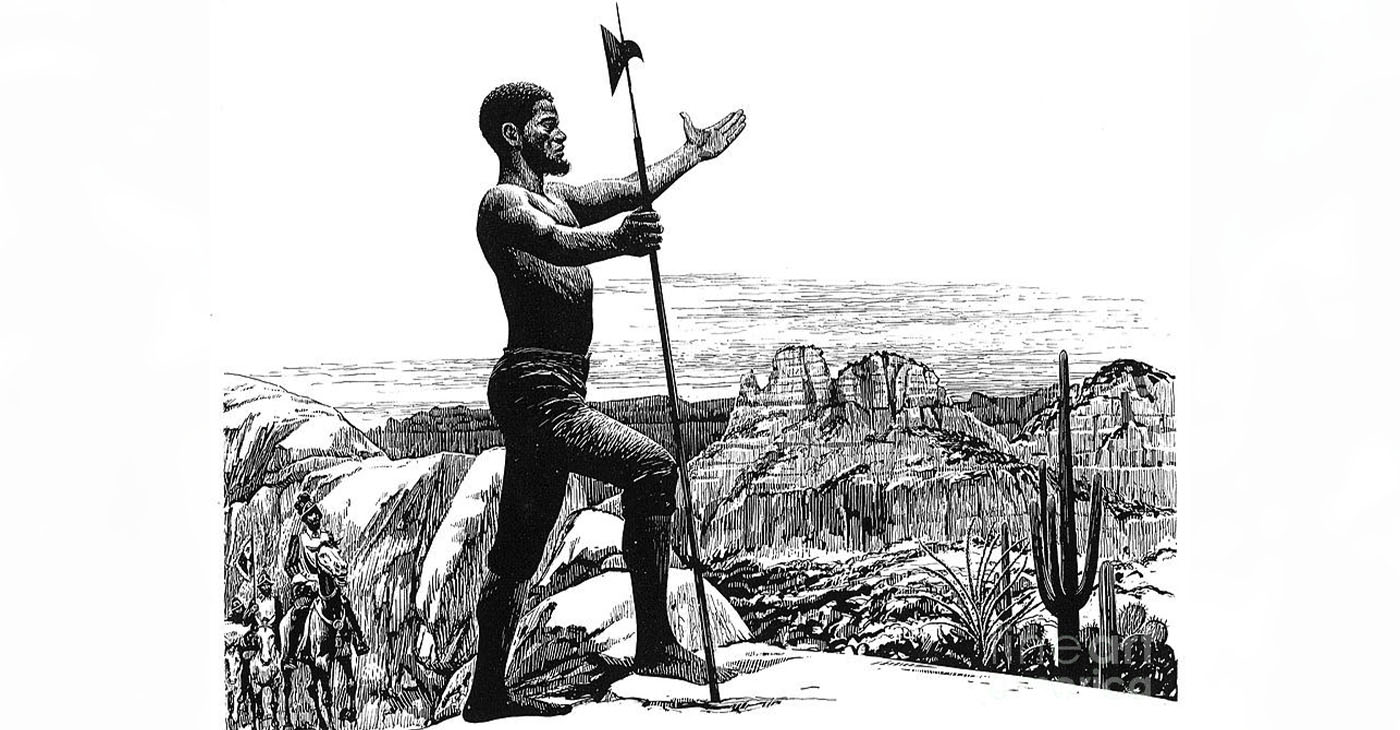#NNPA BlackPress
Estevanico: The Man The Myth, The Legend
NNPA NEWSWIRE — Sometimes called “Mustafa Zemmouri,” “Black Stephen,” “Esteban the Moor” or “Steven Dorantes” (after his owner Andres Dorantes, a Spanish nobleman), Estevanico was a member of the Panfilo de Narvaez 300-man Spanish expedition which arrived in April 1528 near present-day Tampa Bay, Fla. The expedition was largely doomed from the start.
The post Estevanico: The Man The Myth, The Legend first appeared on BlackPressUSA.

The first Black person in the New World
By Merdies Hayes, Editor | Our Weekly
The history of slavery in the Western Hemisphere has, of course, been well documented but there is one name that is often overlooked in within the posterity of Black people in the New World: Estevanico.
Sometimes called “Mustafa Zemmouri,” “Black Stephen,” “Esteban the Moor” or “Steven Dorantes” (after his owner Andres Dorantes, a Spanish nobleman), Estevanico was a member of the Panfilo de Narvaez 300-man Spanish expedition which arrived in April 1528 near present-day Tampa Bay, Fla. The expedition was largely doomed from the start. This was not uncommon among the list of Spanish conquistadors who ventured to the New World seeking fertile land and untold riches imagined from the artful tales of Giovanni Verrazano who explored the northeast, Cabeza de Vaca in the Gulf of Mexico, Hernando Cortes in Mexico, Hernando de Soto near present-day Florida, and Francisco Pizarro far south in Peru.
Who was Estevanico?
Chroniclers from the 16th Century, who were contemporaries of Estevanico, considered him a Negro. However, modern historians claim he was descended from the Hamites who were White residents of North Africa. According to this theory, Estevanico could not have been Black. Historian Caroll L. Riley has asserted that Estevanico was “Black in the sense that we would use the word in modern America. Actually, in modern generic terms I suspect that Estevanico was very mixed.”
Riley also explained that if Estevanico was considered a “Negro,” his mixture must have been mainly Black. Estevanico in 1513 was sold into slavery to the Portuguese in the town of Azemmour, a Portuguese enclave on Morocco’s Atlantic coast. More contemporary accounts have referred to him as an “Arabized Black” or Moor, the latter term often used for Berber natives. History primarily refers to him as a Black African. A Spaniard, Diego de Guzman, reportedly saw Estevanico in 1536 and described him as “brown.”
Estevanico was reared as a Muslim—with some accounts of him converting to Roman Catholicism—but there is little historical account of his religious conversion.
The natives of one tiny island off the mainland coast (Galveston Island near Texas), encountered a strange sight in 1528: A band of emaciated White men lying naked and near dead on the beach. This group, in large part, was what was left from Narvaez’ expedition with de Vaca serving as its treasurer. Narvaez dreamed of riches when he reached the Florida coast and after finding mere traces of gold, he split the group and dispatched the ships toward the River of Palms (today’s Rio Grande) and took the land force toward a reportedly “rich” city brimming with gold and silver called Apalachen (near Tallahassee, Fla.).
A doomed expedition
Instead of finding their heart’s desire in wealth, the only things encountered in the Florida Panhandle were naked Native Indians, low supplies of food and even less game. The 260-man party lasted two weeks in this region, and eventually set out on makeshift boats with sails made from clothing. This was a fateful mistake. There was practically no food left or fresh water to drink. After constantly bailing water from their rickety crafts (and forced to drink salt water), only a few people survived and made it to shore. Narvaez was lost at sea.
Cortes, for his part, had listened faithfully to these “tales of riches” but found neither a queen called “Califia” nor gold and pearls along the west coast. He did, however, step ashore onto what he believed to be an island (Baja California) finding neither riches or fertile land, but would claim the land for the Spanish crown.
Cabeza de Vaca eventually made it to Mexico with only three men, among them Estevanico. There they recounted the horrors of slavery, starvation, cannibalism and disease which took the lives of 90 men. They reportedly posed as shamans, crossing the land curing sick Indians and attracting quite a following in being labeled “children of the sun” because of their long journey from the east. By the spring of 1529, those four men had traveled on foot along the Texas coast to the environs of Matagorda Bay (about 80 miles northeast of Corpus Christi) only to be captured and enslaved by the Coahuiltecan Indians. Six years later the four men managed to escape their bondage and entered Mexico.
Arriving in Texas
Estevanico was assuredly the first African to traverse Texas. In fact, historians believe he was the first African to visit the indigenous people of Mexico and may have reminded the inhabitants of the ancient sculptures of the Olmec civilization in Mesoamerica (1200-900 B.C.) which depicted persons with Black facial features. Estevanico, by extension, may have been considered by the native population as a descendant of the gods. Some writers have claimed that the Olmecs were related to the peoples of Africa, based primarily on their interpretations of said facial features, even contending that epigraphical and osteological evidence may support their claims. Further, some researchers have claimed that the Mesoamerican writing systems are related to African script. To date, however, genetic and immunological studies over the decades have failed to yield evidence of precolumbian African contributions to the indigenous populations of the Americas.
By 1539, Dorantes had either sold or loaned Estevanico to Viceroy Antonio de Mendoza, who later assigned him to the company of Fray Marcos de Niza, the latter charged with leading a follow-up trip to the region of the failed Narvaez expedition. In a strange coincidence, Estevanico and others were surprised to encounter de Vaca near present-day San Antonio, Texas. By then, de Vaca had been working as a trader among the various Native Indian tribes. They resided in that region for about four years with Estevanico working as a shaman or medicine man versed in several Native Indian languages and also demonstrating his prowess as a seasoned explorer.
Estevanico must have been a strange sight to the native peoples. He rode around with a special gourd trimmed with owl feathers that signified his status. He reportedly had an entourage of some 300 natives, kept two Castillian greyhounds as pets, and possessed a special “medicine” wand with bells affixed to it said to ward off (and supposedly cure) various diseases. He also carried with him special plates made of turquoise specifically for his meals. He even had a special lodging constructed fit for a man of his stature.
Dreams of untold riches
Like the others before him, Estevanico was consumed by discovering the Seven Cities of Gold. His ultimate goal was to reach one of the seven famed cities of Cibola (near modern Zuni, NM) which was said to have streets paved with gold. When Estevanico and his entourage arrived at Hawikuh, a Zuni pueblo made of stone buildings several stories high, he expected to be treated as the man of stature he’d become accustomed to.
But the Zuni’s didn’t trust him. They especially disapproved of his gourd covered with owl feathers which were a symbol of death to that tribe. Also, his rather unusual stories about great White kings from far away further drew suspicion among the Zuni tribal leaders. There are two general accounts surrounding the fate of Estevanico. In one scenario, the Zuni people decided he was a spy (or simply a fraud) and killed him. Some accounts contend that he offended the Zuni people so much that they staged three executions eventually cutting up his body into little pieces. A second theory is that the Zunis didn’t kill him and that Estevanico staged his own death with the help of his allies, therefore finally gaining his freedom from slavery. The latter theory is supported by the fact that his body was never found.
His mysterious demise
The Zunis were asked why they killed Estevanico and they said that he claimed a huge army was following him with weapons meant to kill their tribe. Several of his Native Indian escorts reportedly escaped from the Zunis and returned to Mexico to inform Fray Marcos that Estevanico was dead. In his report to Viceroy Mendoza, Marcos said that he continued to travel north to at last enter Cibola (or Hawikuh) and upon arrival he witnessed a chief with Estevanico’s turquoise dinner plates, his two greyhound dogs, and his famed “medicine” bells.
Irrespective of his demise, Estevanico is one of many historical figures of color who manipulated their situation to move between cultures and transcend their humble beginnings. His is a true story of transformation from a slave to a man of legend evidenced by the Zunis memorializing him in a black ogre kachina (a doll measuring about a foot high with protruding teeth, a black goatee and black facial paint) which they called Chakwaina.
A legendary adventure
The tale of Estevanico is more than a story told in the oral tradition. Often, the history and contributions to society by Black persons prior to European settlement in the New World are considered less authentic and reliable in terms of literary content because it was believed Blacks did not ascribe to a written language. Estevanico did not write a diary or narrative of his exploits.
However, two small thin volumes of literature provide a wealth of information about this early explorer. John Upton Terrell published “Estevanico The Black” in 1968 and at only 115 pages, it ranks as one of the most informative books about an extraordinary figure who doesn’t always receive due attention in secondary education. In 1974, “Estebanico” was issued by Helen Rand Parish. Even smaller than Terrell’s book at 128 pages, she wrote that Estevanico could be considered “new historical history” particularly for young readers.
Also, “The Moor’s Account” by Laila Lalami (2015) provides a more fictional account of Estevanico. The author created her own back story about the events that led up to his enslavement and then fills in gaps of what we know about the Narvaez expedition that would eventually place Estevancio’s name in the history books.
No one knows where Estevanico is buried. Hawikuh no longer exists, having been abandoned in 1670 following a series of wars the Zunis fought against the Spaniards and the Apache. But Estevanico’s story, recorded in colorful detail by his fellow explorers Cabeza de Vaca, Fray Marcos, Coronado, and Pedro de Casteneda, endures as one of the great adventures in American lore.
The post Estevanico: The Man The Myth, The Legend first appeared on BlackPressUSA.
#NNPA BlackPress
IN MEMORIAM: Ramona Edelin, Influential Activist and Education Advocate, Dies at 78
NNPA NEWSWIRE — Born on September 4, 1945, in Los Angeles, California, activist Ramona Edelin’s early years were marked by a commitment to education and social justice. According to her HistoryMakers biography, after graduating from Fisk University with a Bachelor’s degree in 1967, she pursued further studies at the University of East Anglia in England. She earned her master’s degree before completing her Ph.D. at Boston University in 1981.
The post IN MEMORIAM: Ramona Edelin, Influential Activist and Education Advocate, Dies at 78 first appeared on BlackPressUSA.

By Stacy M. Brown, NNPA Newswire Senior National Correspondent
@StacyBrownMedia
Once upon a time, Black Americans were simply known as colored people, or Negroes. That is until Ramona Edelin came along. The activist, renowned for her pivotal roles in advancing civil rights, education reform, and community empowerment, died at her D.C. residence last month at the age of 78. Her death, finally confirmed this week by Barnaby Towns, a communications strategist who collaborated with Dr. Edelin, was attributed to cancer.
Born on September 4, 1945, in Los Angeles, California, Edelin’s early years were marked by a commitment to education and social justice. According to her HistoryMakers biography, after graduating from Fisk University with a Bachelor’s degree in 1967, she pursued further studies at the University of East Anglia in England. She earned her master’s degree before completing her Ph.D. at Boston University in 1981.
Edelin’s contributions to academia and activism were manifold. She was pivotal in popularizing the term “African American” alongside Rev. Jesse L. Jackson in the late 1980s.
Jackson had announced the preference for “African American,” speaking for summit organizers that included Dr. Edelin. “Just as we were called Colored, but were not that, and then Negro, but not that, to be called Black is just as baseless,” he said, adding that “African American” “has cultural integrity” and “puts us in our proper historical context.”
Later, Edelin told Ebony magazine, “Calling ourselves African Americans is the first step in the cultural offensive,” while linking the name change to a “cultural renaissance” in which Black Americans reconnected with their history and heritage.
“Who are we if we don’t acknowledge our motherland?” she asked later. “When a child in a ghetto calls himself African American, immediately he’s international. You’ve taken him from the ghetto and put him on the globe.”
The HistoryMakers bio noted that Edelin’s academic pursuits led her to found and chair the Department of African American Studies at Northeastern University, where she established herself as a leading voice.
Transitioning from academia to advocacy, Edelin joined the National Urban Coalition in 1977, eventually ascending to president and CEO. During her tenure, she spearheaded initiatives such as the “Say Yes to a Youngster’s Future” program, which provided crucial support in math, science, and technology to youth and teachers of color in urban areas. Her biography noted that Edelin’s efforts extended nationwide through partnerships with organizations like the National Science Foundation and the United States Department of Education.
President Bill Clinton recognized Edelin’s expertise by appointing her to the Presidential Board on Historically Black Colleges and Universities in 1998. She also co-founded and served as treasurer of the Black Leadership Forum, solidifying her standing as a respected leader in African American communities.
Beyond her professional achievements, Edelin dedicated herself to numerous boards and committees, including chairing the District of Columbia Educational Goals 2000 Panel and contributing to the Federal Advisory Committee for the Black Community Crusade for Children.
Throughout her life, Edelin received widespread recognition for her contributions. Ebony magazine honored her as one of the 100 Most Influential Black Americans, and she received prestigious awards such as the Southern Christian Leadership Award for Progressive Leadership and the IBM Community Executive Program Award.
The post IN MEMORIAM: Ramona Edelin, Influential Activist and Education Advocate, Dies at 78 first appeared on BlackPressUSA.
#NNPA BlackPress
Tennessee State University Board Disbanded by MAGA Loyalists as Assault on DE&I Continues
NNPA NEWSWIRE — Recent legislative actions in Tennessee, such as repealing police reform measures enacted after the killing of Tyre Nichols, underscore a troubling trend of undermining local control and perpetuating racist agendas. The new law preventing local governments from restricting police officers’ authority disregards community efforts to address systemic issues of police violence and racial profiling.
The post Tennessee State University Board Disbanded by MAGA Loyalists as Assault on DE&I Continues first appeared on BlackPressUSA.

By Stacy M. Brown, NNPA Newswire Senior National Correspondent
@StacyBrownMedia
Tennessee State University (TSU), the state’s only public historically Black college and university (HBCU), faces a tumultuous future as Gov. Bill Lee dissolved its board, a move supported by racist conservatives and MAGA Republicans in the Tennessee General Assembly, who follow the lead of the twice-impeached, four-times indicted, alleged sexual predator former President Donald Trump. Educators and others have denounced the move as an attack on diversity, equity, and inclusion (DE&I) and a grave setback for higher education.
Critics argue that TSU’s purported financial mismanagement is a manufactured crisis rooted in decades of underinvestment by the state government. They’ve noted that it continues a trend by conservatives and the racist MAGA movement to eliminate opportunities for Blacks in education, corporate America, and the public sector.
Gevin Reynolds, a former speechwriter for Vice President Kamala Harris, emphasizes in an op-ed that TSU’s financial difficulties are not the result of university leadership because a recent audit found no evidence of fraud or malfeasance.
Reynolds noted that the disbanding of TSU’s board is not an isolated incident but part of a broader assault on DE&I initiatives nationwide. Ten states, including Tennessee, have enacted laws banning DE&I policies on college campuses, while governors appointing MAGA loyalists to university trustee positions further undermine efforts to promote inclusivity and equality.
Moreover, recent legislative actions in Tennessee, such as repealing police reform measures enacted after the killing of Tyre Nichols, underscore a troubling trend of undermining local control and perpetuating racist agendas. The new law preventing local governments from restricting police officers’ authority disregards community efforts to address systemic issues of police violence and racial profiling.
The actions echo historical efforts to suppress Black progress, reminiscent of the violent backlash against gains made during the Reconstruction era. President Joe Biden warned during an appearance in New York last month that Trump desires to bring the nation back to the 18th and 19th centuries – in other words, to see, among other things, African Americans back in the chains of slavery, women subservient to men without any say over their bodies, and all voting rights restricted to white men.
The parallels are stark, with white supremacist ideologies used to justify attacks on Black institutions and disenfranchise marginalized communities, Reynolds argued.
In response to these challenges, advocates stress the urgency of collective action to defend democracy and combat systemic racism. Understanding that attacks on institutions like TSU are symptomatic of broader threats to democratic norms, they call for increased civic engagement and voting at all levels of government.
The actions of people dedicated to upholding the principles of inclusivity, equity, and justice for all will determine the outcome of the ongoing fight for democracy, Reynolds noted. “We are in a war for our democracy, one whose outcome will be determined by every line on every ballot at every precinct,” he stated.
The post Tennessee State University Board Disbanded by MAGA Loyalists as Assault on DE&I Continues first appeared on BlackPressUSA.
#NNPA BlackPress
Braxton Haulcy and the Expansion of Walker|West Music Academy
May 24, 2023 – Walker West Music Academy gets an early start on expansion. Join us for a Wednesday episode of The …
The post Braxton Haulcy and the Expansion of Walker|West Music Academy first appeared on BlackPressUSA.

May 24, 2023 – Walker West Music Academy gets an early start on expansion. Join us for a Wednesday episode of The …
The post Braxton Haulcy and the Expansion of Walker|West Music Academy first appeared on BlackPressUSA.
-

 Community2 weeks ago
Community2 weeks agoFinancial Assistance Bill for Descendants of Enslaved Persons to Help Them Purchase, Own, or Maintain a Home
-

 Activism4 weeks ago
Activism4 weeks agoOakland Post: Week of April 3 – 6, 2024
-

 Business2 weeks ago
Business2 weeks agoV.P. Kamala Harris: Americans With Criminal Records Will Soon Be Eligible for SBA Loans
-

 Community2 weeks ago
Community2 weeks agoAG Bonta Says Oakland School Leaders Should Comply with State Laws to Avoid ‘Disparate Harm’ When Closing or Merging Schools
-

 Activism3 weeks ago
Activism3 weeks agoOakland Post: Week of April 10 – 16, 2024
-

 Community2 weeks ago
Community2 weeks agoOakland WNBA Player to be Inducted Into Hall of Fame
-

 Community2 weeks ago
Community2 weeks agoRichmond Nonprofit Helps Ex-Felons Get Back on Their Feet
-

 Community2 weeks ago
Community2 weeks agoRPAL to Rename Technology Center for Retired Police Captain Arthur Lee Johnson


















































